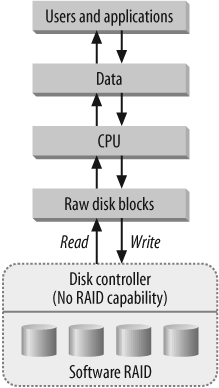Software (Kernel-Managed) RAID
Software RAID means that an array is managed by the kernel, rather than by specialized hardware (see Figure 2-1). The kernel keeps track of how to organize data on many disks while presenting only a single virtual device to applications. This virtual device works just like any normal fixed disk.

Software RAID has unfortunately fallen victim to a FUD (fear, uncertainty, doubt) campaign in the system administrator community. I can’t count the number of system administrators whom I’ve heard completely disparage all forms of software RAID, irrespective of platform. Many of these same people have admittedly not used software RAID in several years, if at all.
Why the stigma? Well, there are a couple of reasons. For one, when software RAID first saw the light of day, computers were still slow and expensive (at least by today’s standards). Offloading a high-performance task like RAID I/O onto a CPU that was likely already heavily overused meant that performing fundamental tasks such as file operations required a tremendous amount of CPU overhead. So, on heavily saturated systems, the simple task of calling the stat[1] function could be extremely slow when compared to systems that didn’t have the additional overhead of managing RAID arrays. But today, even multiprocessor systems are both inexpensive and ...
Get Managing RAID on Linux now with the O’Reilly learning platform.
O’Reilly members experience books, live events, courses curated by job role, and more from O’Reilly and nearly 200 top publishers.

